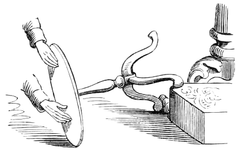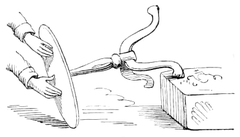The table thus in motion came in contact with the leg of the other table, previously mentioned, near the large ottoman, and, using the leg as a fulcrum, “it directed its claws towards the ottoman, which it attempted to ascend, by inserting one claw in the side, then turning half way round, to make good another step, and so on. It slipped down at the first attempt, but again quietly renewed its task. It was exactly like a child trying to climb up a height. All this time we hardly touched it, being afraid of interfering with its movements, and, above all things, determined not to assist them.” The reader is invited to observe the fallacious effect of the writer’s assumption, that he may speak for the intentions of both his companions. “At last,” he says, by careful and persevering efforts, it accomplished the top of the ottoman, and stood on the summit of the column in the centre, from whence, in a few minutes, it descended to the floor by a similar process; after which we assume that the table was comparatively happy, or that somebody else was well satisfied with its performance. It is perfectly evident that the performers were touching it all along. “We hardly touched it,” says the writer, as if he could tell the manipulative force exerted by either of his companions. In exhibitions of this class, each person present can barely speak for himself. Of the power which may be exerted on a small table by three pairs of hands, it would be difficult to take an exaggerated view, when we know that the effect described may be easily produced by one pair, acting upon the table as in the following designs. Here are the three stages by which the exploit may be effected, in figs. 9, 10, and 11:

Fig. 11.It will be seen that by imparting a circular movement to the top the claws will act like a pair of compasses, and you may make a table walk to the top of an ottoman or any other piece of furniture, the height of which is within the compass of its legs. The sofa-table is aware of the capacities of the Tripod, and that no spiritual influence could enable itself to mount sofas or ottomans. Accordingly, with a modesty becoming its disabilities, it invites the tripod to a performance, and this is the result.
The vague and desultory manner in which the writer next speaks of tables, chairs, and sofas, moving of themselves precludes observations on my part. I can only follow him when he relates with some circumstantiality the various particulars of the incidents and the scene.
A strange vibration is the next phenomenon on which he dwells with any particularity. “It palpitated through the entire room. We listened and watched attentively. The vibration grew stronger and stronger. It was palpably under our feet, and it was like the throbbing which precedes an earthquake, and it continued for two or three minutes, and it could not have been produced by machinery.” Such is the substance of the phenomena described.
Now, I particularly point to this as one of the results which can be produced by the simplest agencies—so simple, that it would be astonishing that any one should regard it as mysterious, but for the assistance which the imagination of the witnesses themselves affords to the simple device of the performer. This drawing-room earthquake may be easily produced by a single pair of feet in vigorous movement to and fro from toe to heel, and if the feet be worked alternately in a room of some extent, a very powerful vibration may thus be created, and sustained with a very little practice, as any one may ascertain by experimenting. If the performer has thin soles and no heels, he will be able to accomplish this on a soft carpet almost without noise, and he has simply to desist when attention is directed to his feet; or, if a lady is the source of the earthquake, her crinoline will conceal her pedal play. Any of my readers with average muscular power, and a slight amount of exertion, may produce such earthquakes in any drawing-room in London, and no one whose mind is not sedulously prepared beforehand will dream of attributing them to spiritual machinery.
The ascent of the table which is next mentioned has been already accounted for in my former paper. It is not alleged in the “Cornhill” article that there was anything extraordinary in the size or weight of the table which appeared to be suspended, so that I am warranted in referring this phenomenon to the leverage power which the Medium obtains by crossing one leg over the other, and by means of which, with a little practice, considerable weights may be raised in the air.

